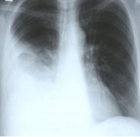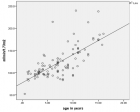Abstract
Case Report
A rare case: Congenital Megalourethra in prune belly syndrome
Numan Baydilli*, Ismail Selvi and Emre Can Akınsal
Published: 30 January, 2018 | Volume 2 - Issue 1 | Pages: 001-003
Introduction: Prune Belly syndrome is a disease characterized by abdominal muscle defect, bilateral cryptorchidsim and urinary system anomalies (reflux megaureter, hydronephrosis, etc.). Pulmonary, cardiac, and gastrointestinal anomalies may also be present. Management of these rare cases is very important. In this case, the clinical course of a patient with Prune Belly syndrome with megaurethra is presented.
Case: The patient from the first gestation and parturition with birth weight of 2500 g and 38 weeks was hospitalized because of the bilateral hydronephrosis. His physical examination revealed undescended testicles and a large penis. The abdominal muscles were not very atrophic. The size of the kidney was small, bilateral hydroureteronephrosis and wide posterior urethra on the ultrasound. Renal function tests were progressively disturbed and the patient underwent cystourethroscopy for diagnostic purposes in terms of posterior urethral valve. A large diverticulum was found in anterior urethra. Prune Belly Syndrome was thought because the orifices were in appearance of reflux. The vesicostomy was applied. After vesicostomy the renal function tests got better but he was hospitalized due to urosepsis two times. In cystoscopic examination, the diverticulum in the urethra was filled with urine and the drainage was very slow. Phimosis was opened with dorsal slit technique. Cutaneous urethrostomy was proximal to the anterior diverticulum.
Conclusion: Prune Belly syndrome should be considered in patients with megaurethra and postrenal or renal insufficiency although there are no obvious clinical findings. In Prune Belly cases, via a large penis with obstruction signs, anterior urethral diverticulum should be considered.
Read Full Article HTML DOI: 10.29328/journal.acr.1001005 Cite this Article Read Full Article PDF
Keywords:
Congenital megalourethra; Prune Belly Syndrome; Urogenital anomalies
References
- Kamra S, Santpur U, Puri N, Neetu Pippet. Prune belly syndrome: a case of early prenatal diagnosis. Int J Reprod Contracept Obstet Gynecol. 2017; 6: 1652-1655. Ref.: https://goo.gl/bDPLCu
- Berrocal T, Loepez-Pereira P, Arjonilla A, Gutiérrez J. Anomalies of the distal ureter, bladder, and urethra in children: embryologic, radiologic, and pathologic features. Radiographics. 2002; 22: 1139-1164. Ref.: https://goo.gl/zBQkmQ
- Rabinowitz R, Schillinger JF. Prune belly syndrome in the female subject. J Urol. 1977; 118: 454-456. Ref.: https://goo.gl/yA1ePi
- Sellers BB Jr, McNeal R, Smith RV, Griswold WR, Mendoza SA. Congenital megalourethra associated with prune belly syndrome. J Urol. 1976; 116: 814-815. Ref.: https://goo.gl/6a3pM7
- Rogers S, Sohaey R. Prune belly with megalourethra. Ultrasound Q. 2013; 29: 235-236. Ref.: https://goo.gl/Nn3mpd
- Seki N, Senoh K, Kubo S, Tsunoda R. Congenital megalourethra: a case report. Int J Urol. 1998; 5: 191-193. Ref.: https://goo.gl/64ZUtv
- Perrotin F, Ayeva-Derman M, Lardy H, Cloarec S, Lansac J, et al. Prenatal diagnosis and postnatal outcome of congenital megalourethra. Report of two cases. Fetal Diagn Ther. 2001; 16: 123-128. Ref.: https://goo.gl/JbtsWz
- Bangroo AK, Tiwari S, Khetri R, Sahni M. Congenital pouch colon with prune belly syndrome and megalourethra. Pediatr Surg Int. 2005; 21: 474-477. Ref.: https://goo.gl/nau6PC
Figures:

Figure 1
Similar Articles
-
A rare case: Congenital Megalourethra in prune belly syndromeNuman Baydilli*,Ismail Selvi,Emre Can Akınsal. A rare case: Congenital Megalourethra in prune belly syndrome. . 2018 doi: 10.29328/journal.acr.1001005; 2: 001-003
Recently Viewed
-
High-Performance Liquid Chromatography (HPLC): A reviewAbdu Hussen Ali*. High-Performance Liquid Chromatography (HPLC): A review. Ann Adv Chem. 2022: doi: 10.29328/journal.aac.1001026; 6: 010-020
-
Drug Rehabilitation Centre-based Survey on Drug Dependence in District Shimla Himachal PradeshKanishka Saini,Palak Sharma,Bhawna Sharma*,Atul Kumar Dubey,Muskan Bhatnoo,Prajkta Thakur,Vanshika Chandel,Ritika Sinha. Drug Rehabilitation Centre-based Survey on Drug Dependence in District Shimla Himachal Pradesh. J Addict Ther Res. 2025: doi: 10.29328/journal.jatr.1001032; 9: 001-006
-
Poly-dopamine-Beta-Cyclodextrin Modified Glassy Carbon Electrode as a Sensor for the Voltammetric Detection of L-Tryptophan at Physiological pHMohammad Hasanzadeh*,Nasrin Shadjou,Sattar Sadeghi,Ahad Mokhtarzadeh,Ayub karimzadeh. Poly-dopamine-Beta-Cyclodextrin Modified Glassy Carbon Electrode as a Sensor for the Voltammetric Detection of L-Tryptophan at Physiological pH . J Forensic Sci Res. 2017: doi: 10.29328/journal.jfsr.1001001; 1: 001-009
-
WMW: A Secure, Web based Middleware for C4I Interoperable ApplicationsNida Zeeshan*. WMW: A Secure, Web based Middleware for C4I Interoperable Applications. J Forensic Sci Res. 2017: doi: 10.29328/journal.jfsr.1001002; 1: 010-017
-
Associations of Burnout, Secondary Traumatic Stress and Individual Differences among Correctional Psychologists`Irina G. Malkina-Pykh*. Associations of Burnout, Secondary Traumatic Stress and Individual Differences among Correctional Psychologists`. J Forensic Sci Res. 2017: doi: 10.29328/journal.jfsr.1001003; 1: 018-034
Most Viewed
-
Evaluation of Biostimulants Based on Recovered Protein Hydrolysates from Animal By-products as Plant Growth EnhancersH Pérez-Aguilar*, M Lacruz-Asaro, F Arán-Ais. Evaluation of Biostimulants Based on Recovered Protein Hydrolysates from Animal By-products as Plant Growth Enhancers. J Plant Sci Phytopathol. 2023 doi: 10.29328/journal.jpsp.1001104; 7: 042-047
-
Sinonasal Myxoma Extending into the Orbit in a 4-Year Old: A Case PresentationJulian A Purrinos*, Ramzi Younis. Sinonasal Myxoma Extending into the Orbit in a 4-Year Old: A Case Presentation. Arch Case Rep. 2024 doi: 10.29328/journal.acr.1001099; 8: 075-077
-
Feasibility study of magnetic sensing for detecting single-neuron action potentialsDenis Tonini,Kai Wu,Renata Saha,Jian-Ping Wang*. Feasibility study of magnetic sensing for detecting single-neuron action potentials. Ann Biomed Sci Eng. 2022 doi: 10.29328/journal.abse.1001018; 6: 019-029
-
Pediatric Dysgerminoma: Unveiling a Rare Ovarian TumorFaten Limaiem*, Khalil Saffar, Ahmed Halouani. Pediatric Dysgerminoma: Unveiling a Rare Ovarian Tumor. Arch Case Rep. 2024 doi: 10.29328/journal.acr.1001087; 8: 010-013
-
Physical activity can change the physiological and psychological circumstances during COVID-19 pandemic: A narrative reviewKhashayar Maroufi*. Physical activity can change the physiological and psychological circumstances during COVID-19 pandemic: A narrative review. J Sports Med Ther. 2021 doi: 10.29328/journal.jsmt.1001051; 6: 001-007

HSPI: We're glad you're here. Please click "create a new Query" if you are a new visitor to our website and need further information from us.
If you are already a member of our network and need to keep track of any developments regarding a question you have already submitted, click "take me to my Query."















































































































































